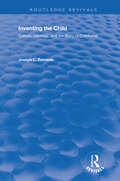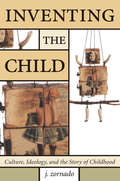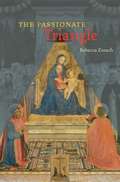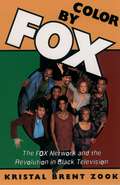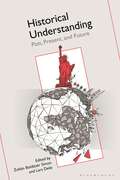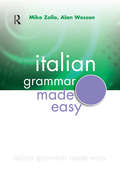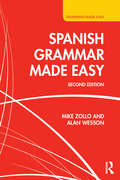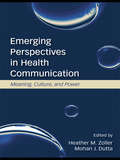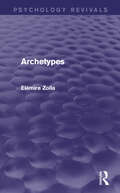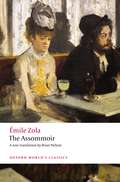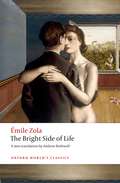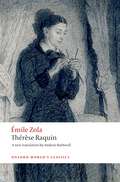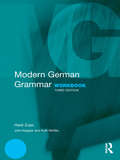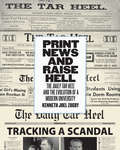- Table View
- List View
Inventing the Child: Culture, Ideology and the Story of the Child
by Joseph L. ZornadoThis book traces the historical roots of Western culture's stories of childhood in which the child is subjugated to the adult. Going back 400 years, it looks again at Hamlet, fairy tales of the Brothers Grimm, and Walt Disney cartoons. Inventing the Child is a highly entertaining, humorous, and at times acerbic account of what it means to be a child (and a parent) in America at the dawn of the new millennium. John Zornado explores the history and development of the concept of childhood, starting with the works of Calvin, Freud, and Rousseau and culminating with the modern "consumer" childhood of Dr. Spock and television. The volume discusses major media depictions of childhood and examines the ways in which parents use different forms of media to swaddle, educate, and entertain their children. Zornado argues that the stories we tell our children contain the ideologies of the dominant culture--which, more often than not, promote "happiness" at all costs, materialism as the way to happiness, and above all, obedience to the dominant order.
Inventing the Child (Children's Literature and Culture)
by John ZornadoNow in paperback, Inventing the Child is a highly entertaining, humorous, and at times acerbic account of what it means to be a child (and a parent) in America at the dawn of the new millennium. J. Zornado explores the history and development of the concept of childhood, starting with the works of Calvin, Freud, and Rousseau and culminating with the modern 'consumer' childhood of Dr. Spock and television. The volume discusses major media depictions of childhood and examines the ways in which parents use different forms of media to swaddle, educate, and entertain their children. Zornado argues that the stories we tell our children contain the ideologies of the dominant culture - which, more often than not, promote 'happiness' at all costs, materialism as the way to happiness, and above all, obedience to the dominant order.
Inventing the Child: Culture (Children's Literature and Culture #Vol. 17)
by John ZornadoNow in paperback, Inventing the Child is a highly entertaining, humorous, and at times acerbic account of what it means to be a child (and a parent) in America at the dawn of the new millennium. J. Zornado explores the history and development of the concept of childhood, starting with the works of Calvin, Freud, and Rousseau and culminating with the modern 'consumer' childhood of Dr. Spock and television. The volume discusses major media depictions of childhood and examines the ways in which parents use different forms of media to swaddle, educate, and entertain their children. Zornado argues that the stories we tell our children contain the ideologies of the dominant culture - which, more often than not, promote 'happiness' at all costs, materialism as the way to happiness, and above all, obedience to the dominant order.
The Passionate Triangle
by Rebecca ZorachTriangles abounded in the intellectual culture of early modern Europe—the Christian Trinity was often mapped as a triangle, for instance, and perspective, a characteristic artistic technique, is based on a triangular theory of vision. Renaissance artists, for their part, often used shapes and lines to arrange figures into a triangle on the surface of a painting—a practice modern scholars call triangular composition. But is there secret meaning in the triangular arrangements artists used, or just a pleasing symmetry? What do triangles really tell us about the European Renaissance and its most beguiling works of art? In this book, Rebecca Zorach takes us on a lively hunt for the triangle’s embedded significance. From the leisure pursuits of Egyptian priests to Jacopo Tintoretto’s love triangles, Zorach explores how the visual and mathematical properties of triangles allowed them to express new ideas and to inspire surprisingly intense passions. Examining prints and paintings as well as literary, scientific, and philosophical texts, The Passionate Triangle opens up an array of new ideas, presenting unexpected stories of the irrational, passionate, melancholic, and often erotic potential of mathematical thinking before the Scientific Revolution.
The Passionate Triangle
by Rebecca ZorachTriangles abounded in the intellectual culture of early modern Europe—the Christian Trinity was often mapped as a triangle, for instance, and perspective, a characteristic artistic technique, is based on a triangular theory of vision. Renaissance artists, for their part, often used shapes and lines to arrange figures into a triangle on the surface of a painting—a practice modern scholars call triangular composition. But is there secret meaning in the triangular arrangements artists used, or just a pleasing symmetry? What do triangles really tell us about the European Renaissance and its most beguiling works of art? In this book, Rebecca Zorach takes us on a lively hunt for the triangle’s embedded significance. From the leisure pursuits of Egyptian priests to Jacopo Tintoretto’s love triangles, Zorach explores how the visual and mathematical properties of triangles allowed them to express new ideas and to inspire surprisingly intense passions. Examining prints and paintings as well as literary, scientific, and philosophical texts, The Passionate Triangle opens up an array of new ideas, presenting unexpected stories of the irrational, passionate, melancholic, and often erotic potential of mathematical thinking before the Scientific Revolution.
The Passionate Triangle
by Rebecca ZorachTriangles abounded in the intellectual culture of early modern Europe—the Christian Trinity was often mapped as a triangle, for instance, and perspective, a characteristic artistic technique, is based on a triangular theory of vision. Renaissance artists, for their part, often used shapes and lines to arrange figures into a triangle on the surface of a painting—a practice modern scholars call triangular composition. But is there secret meaning in the triangular arrangements artists used, or just a pleasing symmetry? What do triangles really tell us about the European Renaissance and its most beguiling works of art? In this book, Rebecca Zorach takes us on a lively hunt for the triangle’s embedded significance. From the leisure pursuits of Egyptian priests to Jacopo Tintoretto’s love triangles, Zorach explores how the visual and mathematical properties of triangles allowed them to express new ideas and to inspire surprisingly intense passions. Examining prints and paintings as well as literary, scientific, and philosophical texts, The Passionate Triangle opens up an array of new ideas, presenting unexpected stories of the irrational, passionate, melancholic, and often erotic potential of mathematical thinking before the Scientific Revolution.
The Passionate Triangle
by Rebecca ZorachTriangles abounded in the intellectual culture of early modern Europe—the Christian Trinity was often mapped as a triangle, for instance, and perspective, a characteristic artistic technique, is based on a triangular theory of vision. Renaissance artists, for their part, often used shapes and lines to arrange figures into a triangle on the surface of a painting—a practice modern scholars call triangular composition. But is there secret meaning in the triangular arrangements artists used, or just a pleasing symmetry? What do triangles really tell us about the European Renaissance and its most beguiling works of art? In this book, Rebecca Zorach takes us on a lively hunt for the triangle’s embedded significance. From the leisure pursuits of Egyptian priests to Jacopo Tintoretto’s love triangles, Zorach explores how the visual and mathematical properties of triangles allowed them to express new ideas and to inspire surprisingly intense passions. Examining prints and paintings as well as literary, scientific, and philosophical texts, The Passionate Triangle opens up an array of new ideas, presenting unexpected stories of the irrational, passionate, melancholic, and often erotic potential of mathematical thinking before the Scientific Revolution.
Color by Fox: The Fox Network and the Revolution in Black Television (W.E.B. Du Bois Institute)
by Kristal Brent ZookFollowing the overwhelming success of "The Cosby Show" in the 1980s, an unprecedented shift took place in television history: white executives turned to black dollars as a way of salvaging network profits lost in the war against video cassettes and cable T.V. Not only were African-American viewers watching disproportionately more network television than the general population but, as Nielsen finally realized, they preferred black shows. As a result, African-American producers, writers, directors, and stars were given an unusual degree of creative control over shows such as "The Fresh Prince of Bel Air," "Roc," "Living Single," and "New York Undercover". What emerged were radical representations of African-American memory and experience. Offering a fascinating examination of the explosion of black television programming in the 1980s and 1990s, this book provides, for the first time ever, an interpretation of black TV based in both journalism and critical theory. Locating a persistent black nationalist desire--a yearning for home and community--in the shows produced by and for African-Americans in this period, Kristal Brent Zook shows how the Fox hip-hop sitcom both reinforced and rebelled against earlier black sitcoms from the sixties and seventies. Incorporating interviews with such prominent executives, producers, and stars as Keenen Ivory Wayans, Sinbad, Quincy Jones, Robert Townsend, Charles Dutton, Yvette Lee Bowser, and Ralph Farquhar, this study looks at both production and reception among African-American viewers, providing nuanced readings of the shows themselves as well as the sociopolitical contexts in which they emerged. While black TV during this period may seem trivial or buffoonish to some, Color by Fox reveals its deep-rooted ties to African-American protest literature and autobiography, and a desire for social transformation.
Historical Understanding: Past, Present, and Future
by Zoltán Boldizsár Simon and Lars DeileThe first decades of the new century shake old certainties. In a whirlwind of profound changes, do we have more history or less? Does history overwhelm us in all domains of life or is historical understanding in yet another crisis? The answers do not come easily. The recent demise of humanities education, the technological alterations of our social lifeworlds and the human condition, the anthropogenic changes in the Earth system, the growing sense of memory, trauma and historical injustice as alternative approaches to the past, seem to entail contradictions and complexities that do not fit very well with our existing notions of historical understanding. Historical thought as we know it is facing manifold challenges, and we struggle to grasp a larger picture that could encompass them.Boasting a range of contributions from leading scholars, this volume attempts just that. In an innovative collection of short essays, Historical Understanding explores the current shape of historical understanding today, by surveying a variety of historical relations to the past, present, and future in the face of socio-political, ecological and technological upheavals. This book is an invaluable research tool for students and researchers alike, presenting a kaleidoscope-like overview of manifold new ways which we navigate “historically” in coping with present-day challenges, both in wider society and in historiography
Italian Grammar Made Easy (Grammar Made Easy)
by Mike Zollo Alan WessonThe Grammar Made Easy series is ideal for complete beginners as well as for those non-linguists who have some knowledge of the language but need to know the basics of grammar to progress beyond phrasebook level.The books consist of seven units that present basic grammar topics in an accessible and non-patronising manner. The interactive CD-ROM provides extensive interactive grammar practice, it contains around 220 activities (those included in the book plus extra ones) covering all the language in Italian Grammar Made Easy. Learners work at their own pace and move through the different sections with ease.Numerous grammar tips are at hand if needed. All the correct answers will be recorded so that learners can practise their listening and pronunciation skills.The CD-ROM can be used with the book or on its own as a revision tool.
Italian Grammar Made Easy: Italian Grammar Made Easy (Grammar Made Easy)
by Mike Zollo Alan WessonThe Grammar Made Easy series is ideal for complete beginners as well as for those non-linguists who have some knowledge of the language but need to know the basics of grammar to progress beyond phrasebook level.The books consist of seven units that present basic grammar topics in an accessible and non-patronising manner. The interactive CD-ROM provides extensive interactive grammar practice, it contains around 220 activities (those included in the book plus extra ones) covering all the language in Italian Grammar Made Easy. Learners work at their own pace and move through the different sections with ease.Numerous grammar tips are at hand if needed. All the correct answers will be recorded so that learners can practise their listening and pronunciation skills.The CD-ROM can be used with the book or on its own as a revision tool.
Spanish Grammar Made Easy
by Michael A. Zollo Alan WessonSpanish Grammar Made Easy is the ideal introduction to the basics of Spanish grammar for anyone new to the language or looking to refresh their knowledge. This second edition features: concise and jargon-free explanations supported by examples exercises throughout to reinforce learning a 'fast-track' option for more advanced learners a full answer key, making the Grammar ideal for self-study. A companion website is available at http://cw.routledge.com/textbooks/9781138955820. With over 200 additional exercises and audio, it provides ample grammar practice for learners as well as the opportunity to practise listening and pronunciation skills. Spanish Grammar Made Easy presents the essential patterns and rules of the Spanish language in a clear and accessible manner. It is the ideal Grammar for those wishing to supplement their learning and move beyond the phrasebook level.
Spanish Grammar Made Easy (Grammar Made Easy Ser.)
by Michael A. Zollo Alan WessonSpanish Grammar Made Easy is the ideal introduction to the basics of Spanish grammar for anyone new to the language or looking to refresh their knowledge. This second edition features: concise and jargon-free explanations supported by examples exercises throughout to reinforce learning a 'fast-track' option for more advanced learners a full answer key, making the Grammar ideal for self-study. A companion website is available at http://cw.routledge.com/textbooks/9781138955820. With over 200 additional exercises and audio, it provides ample grammar practice for learners as well as the opportunity to practise listening and pronunciation skills. Spanish Grammar Made Easy presents the essential patterns and rules of the Spanish language in a clear and accessible manner. It is the ideal Grammar for those wishing to supplement their learning and move beyond the phrasebook level.
Emerging Perspectives in Health Communication: Meaning, Culture, and Power
by Heather Zoller Mohan J. DuttaThis volume provides the theoretical, methodological, and praxis-driven issues in research on interpretive, critical, and cultural approaches to health communication. It includes an international collection of contributors, and highlights non-traditional (non-Western) perspectives on health communication.
Emerging Perspectives in Health Communication: Meaning, Culture, and Power (Leas Communication Ser.)
by Heather Zoller Mohan J. DuttaThis volume provides the theoretical, methodological, and praxis-driven issues in research on interpretive, critical, and cultural approaches to health communication. It includes an international collection of contributors, and highlights non-traditional (non-Western) perspectives on health communication.
Archetypes (Psychology Revivals)
by Elémire ZollaMan is dominated by his archetypes; they mould not only his history but his dreams. But how are we to define and evaluate them? Is it perhaps possible for us to relate more creatively to them? Originally published in 1981, these are some of the questions raised by this title. To answer them the author gathered together a vast amount of material drawn from Eastern and Western traditions, from science, literature, art and poetry. The answers he puts forward are often highly original and will surely challenge many of our most cherished patterns of thought. There emerges from this book what can only be described as a global metaphysical system, yet the author’s language is not that of an ordinary metaphysical treatise, and what he writes offered new challenge and hope to those suffering from the despair and cynicism engendered by a great deal in modern society at the time. Zolla does not, however, advocate a return to earlier historical patterns, nor is he proposing a new Utopia, but rather offers us a brilliant series of lessons in the art of centring. In the words of Bernard Wall, writing in the Times Literary Supplement, Zolla’s ‘deep, polymathic probing of the terms of human existence makes it sensible to compare him with Simone Weil, while some of his conclusions about ultimate mysteries – expressed in signs, symbols and sacraments, the sense of which we have lost – will make us think of the later T. S. Eliot’.
Archetypes (Psychology Revivals)
by Elémire ZollaMan is dominated by his archetypes; they mould not only his history but his dreams. But how are we to define and evaluate them? Is it perhaps possible for us to relate more creatively to them? Originally published in 1981, these are some of the questions raised by this title. To answer them the author gathered together a vast amount of material drawn from Eastern and Western traditions, from science, literature, art and poetry. The answers he puts forward are often highly original and will surely challenge many of our most cherished patterns of thought. There emerges from this book what can only be described as a global metaphysical system, yet the author’s language is not that of an ordinary metaphysical treatise, and what he writes offered new challenge and hope to those suffering from the despair and cynicism engendered by a great deal in modern society at the time. Zolla does not, however, advocate a return to earlier historical patterns, nor is he proposing a new Utopia, but rather offers us a brilliant series of lessons in the art of centring. In the words of Bernard Wall, writing in the Times Literary Supplement, Zolla’s ‘deep, polymathic probing of the terms of human existence makes it sensible to compare him with Simone Weil, while some of his conclusions about ultimate mysteries – expressed in signs, symbols and sacraments, the sense of which we have lost – will make us think of the later T. S. Eliot’.
The Assommoir (Oxford World's Classics)
by Émile Zola'in this life, even if you don't ask for much you still end up with bugger all!' In a run-down quarter of Paris, Gervaise Macquart struggles to earn a living and support her family. She earns a pittance washing other people's dirty clothes in the local washhouse, and dreams of having her own laundry. But in order to start her business she must incur debt, and her feckless husband cannot resist the lure of the Assommoir, the local bar that supplies all the working men with cheap spirits and absinthe. As her money troubles grow, so Gervaise's life begins to spiral out of control, and she is trapped in a vicious web of want and neglect. The Assommoir is a pivotal novel in Zola's Rougon-Macquart series. In it he lays bare the terrible poverty of the Parisian underclass, living in overcrowded tenements, addicted to drink, a world of squalor, and casual violence. It contains some of Zola's most powerful and graphic writing, unforgettable portrayals of individuals and their environment, and the fine line between self-respect and ruin.
The Assommoir (Oxford World's Classics)
by Émile Zola'in this life, even if you don't ask for much you still end up with bugger all!' In a run-down quarter of Paris, Gervaise Macquart struggles to earn a living and support her family. She earns a pittance washing other people's dirty clothes in the local washhouse, and dreams of having her own laundry. But in order to start her business she must incur debt, and her feckless husband cannot resist the lure of the Assommoir, the local bar that supplies all the working men with cheap spirits and absinthe. As her money troubles grow, so Gervaise's life begins to spiral out of control, and she is trapped in a vicious web of want and neglect. The Assommoir is a pivotal novel in Zola's Rougon-Macquart series. In it he lays bare the terrible poverty of the Parisian underclass, living in overcrowded tenements, addicted to drink, a world of squalor, and casual violence. It contains some of Zola's most powerful and graphic writing, unforgettable portrayals of individuals and their environment, and the fine line between self-respect and ruin.
The Bright Side of Life (Oxford World's Classics)
by Émile Zola'Neither spoke another word, they were gripped by a shared, unthinking madness as they plunged headlong together into vertiginous rapture.' Orphaned with a substantial inheritance at the age of ten, Pauline Quenu is taken from Paris to live with her relatives, Monsieur and Madame Chanteau and their son Lazare, in the village of Bonneville on the wild Normandy coast. Her presence enlivens the household and Pauline is the only one who can ease Chanteau's gout-ridden agony. Her love of life contrasts with the insularity and pessimism that infects the family, especially Lazare, for whom she develops a devoted passion. Gradually Madame Chanteau starts to take advantage of Pauline's generous nature, and jealousy and resentment threaten to blight all their lives. The arrival of a pretty family friend, Louise, brings tensions to a head. The twelfth novel in the Rougon Macquart series, The Bright Side of Life is remarkable for its depiction of intense emotions and physical and mental suffering. The precarious location of Bonneville and the changing moods of the sea mirror the turbulent relations of the characters, and as the story unfolds its title comes to seem ever more ironic.
The Bright Side of Life (Oxford World's Classics)
by Émile Zola'Neither spoke another word, they were gripped by a shared, unthinking madness as they plunged headlong together into vertiginous rapture.' Orphaned with a substantial inheritance at the age of ten, Pauline Quenu is taken from Paris to live with her relatives, Monsieur and Madame Chanteau and their son Lazare, in the village of Bonneville on the wild Normandy coast. Her presence enlivens the household and Pauline is the only one who can ease Chanteau's gout-ridden agony. Her love of life contrasts with the insularity and pessimism that infects the family, especially Lazare, for whom she develops a devoted passion. Gradually Madame Chanteau starts to take advantage of Pauline's generous nature, and jealousy and resentment threaten to blight all their lives. The arrival of a pretty family friend, Louise, brings tensions to a head. The twelfth novel in the Rougon Macquart series, The Bright Side of Life is remarkable for its depiction of intense emotions and physical and mental suffering. The precarious location of Bonneville and the changing moods of the sea mirror the turbulent relations of the characters, and as the story unfolds its title comes to seem ever more ironic.
Thérèse Raquin (Oxford World's Classics)
by Émile ZolaThérèse Raquin is a clinically observed, sinister tale of adultery and murder among the lower orders in nineteenth-century Paris. Zola's dispassionate dissection of the motivations of his characters, mere `human beasts' who kill in order to satisfy their lust, is much more than an atmospheric Second Empire period-piece. Many readers were scandalized by an approach to character-drawing which seemed to undermine not only the moral values of a deeply conservative society, but also the whole code of psychological description on which the realist novel was based. Together with the important `Preface to the Second Edition' in which Zola defended himself against charges of immorality, Thérèse Raquin stands as a key early manifesto of the French Naturalist movement, of which Zola was the founding father. Even today, this novel has lost none of its power to shock. This new translation is based on the second edition of 1868. The Introduction situates the novel in the context of Naturalism, medicine, and the scientific ideas of Zola's day. ABOUT THE SERIES: For over 100 years Oxford World's Classics has made available the widest range of literature from around the globe. Each affordable volume reflects Oxford's commitment to scholarship, providing the most accurate text plus a wealth of other valuable features, including expert introductions by leading authorities, helpful notes to clarify the text, up-to-date bibliographies for further study, and much more.
Modern German Grammar Workbook (Modern Grammar Workbooks)
by Heidi Zojer John Klapper Ruth Whittle William J Dodd Christine Eckhard-BlackModern German Grammar Workbook, Third Edition, is an innovative book of exercises and language tasks for intermediate and advanced learners of German. The book is divided into three sections: Section 1 provides exercises based on essential grammatical structures. Section 2 practises everyday functions (e.g. making introductions, apologising, expressing needs). Section 3 contains realistic role-plays in short scenes, set in a range of different contexts. A comprehensive answer key at the back of the book enables you to check on your progress. Implementing feedback from users of the second edition, this third edition now features: even more extensive cross-referencing to the related Modern German Grammar, Third Edition spelling following the latest reform representation of the German of Switzerland and Austria. Modern German Grammar Workbook, Third Edition, is ideal for all learners who want to deepen their knowledge of German, including intermediate and advanced students at schools, in adult education and within higher education. It can be used independently or alongside Modern German Grammar, Third Edition (ISBN 978-0-415-56726-8) also published by Routledge.
Modern German Grammar Workbook (Modern Grammar Workbooks)
by Heidi Zojer John Klapper Ruth Whittle William J Dodd Christine Eckhard-BlackModern German Grammar Workbook, Third Edition, is an innovative book of exercises and language tasks for intermediate and advanced learners of German. The book is divided into three sections: Section 1 provides exercises based on essential grammatical structures. Section 2 practises everyday functions (e.g. making introductions, apologising, expressing needs). Section 3 contains realistic role-plays in short scenes, set in a range of different contexts. A comprehensive answer key at the back of the book enables you to check on your progress. Implementing feedback from users of the second edition, this third edition now features: even more extensive cross-referencing to the related Modern German Grammar, Third Edition spelling following the latest reform representation of the German of Switzerland and Austria. Modern German Grammar Workbook, Third Edition, is ideal for all learners who want to deepen their knowledge of German, including intermediate and advanced students at schools, in adult education and within higher education. It can be used independently or alongside Modern German Grammar, Third Edition (ISBN 978-0-415-56726-8) also published by Routledge.
Print News and Raise Hell: The Daily Tar Heel and the Evolution of a Modern University
by Kenneth Joel ZogryFor over 125 years, the Daily Tar Heel has chronicled life at the University of North Carolina at Chapel Hill and at times pushed and prodded the university community on issues of local, state, and national significance. Thousands of students have served on its staff, many of whom have gone on to prominent careers in journalism and other influential fields. Print News and Raise Hell engagingly narrates the story of the newspaper's development and the contributions of many of the people associated with it. Kenneth Joel Zogry shows how the paper has wrestled over the years with challenges to academic freedom, freedom of speech, and freedom of the press, while confronting issues such as the evolution of race, gender, and sexual equality on campus and long-standing concerns about the role of major athletics at an institution of higher learning. The story of the paper, the social media platform of its day, uncovers many dramatic but perhaps forgotten events at UNC since the late nineteenth century, and along with many photographs and cartoons not published for decades, opens a fascinating window into Tar Heel history. Examining how the campus and the paper have dealt with many challenging issues for more than a century, Zogry reveals the ways in which the history of the Daily Tar Heel is deeply intertwined with the past and present of the nation's oldest public university.
